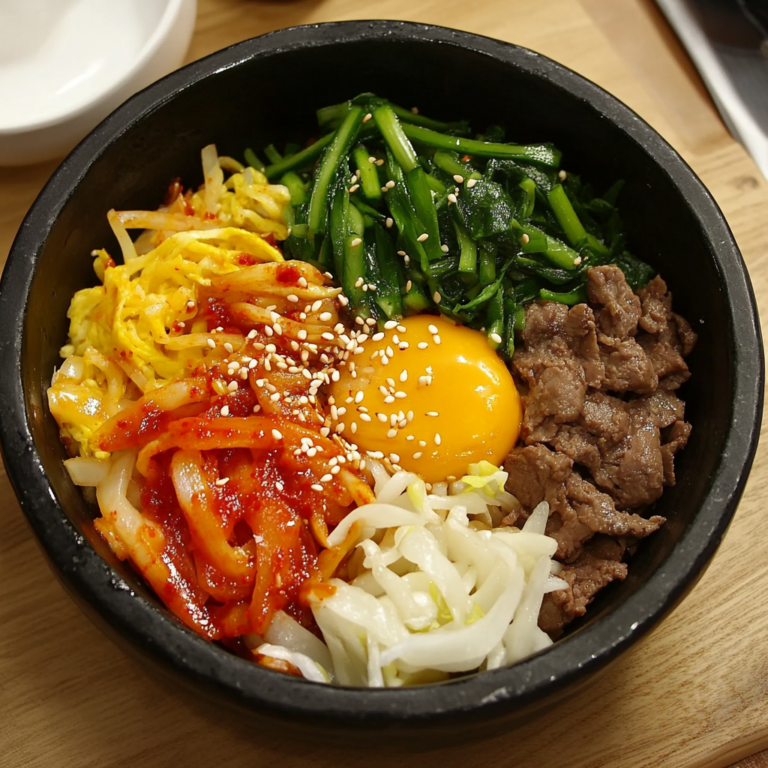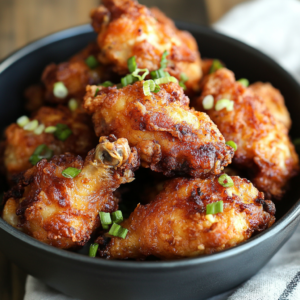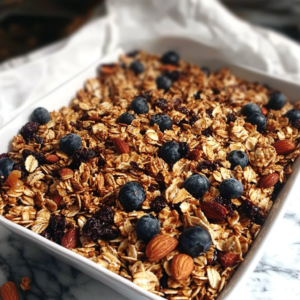Bibimbap is a classic Korean rice dish, typically served with a combination of vegetables, beef, a fried egg, and spicy gochujang chili paste. It’s not only visually vibrant but also packed with a variety of textures and flavors, making it a popular meal. Traditionally, bibimbap was enjoyed on the eve of the Lunar New Year to use up leftovers. Whether you’re looking for a quick weeknight dinner or a dish with complex flavors, this bibimbap recipe is a satisfying choice.
Quick Benefits
- High in Protein: This dish is packed with protein from the beef and egg, making it a filling and satisfying meal.
- Nutrient-Dense: With fresh vegetables like spinach, carrots, and cucumber, bibimbap is full of vitamins and fiber.
- Customizable: You can adjust the level of spice with gochujang, or substitute it for a milder option like soy sauce or Sriracha.
- Balanced Meal: This rice bowl includes a perfect balance of protein, healthy fats, carbohydrates, and vegetables, providing a well-rounded meal.
Essential Ingredients
- English Cucumber (1, cut into matchsticks): Adds a refreshing crunch to the dish.
- Gochujang (¼ cup, optional): A traditional Korean hot pepper paste that adds a spicy kick and depth of flavor.
- Fresh Spinach (1 bunch, cut into thin strips): A nutrient-packed vegetable that provides vitamins and iron.
- Soy Sauce (1 tablespoon): Adds saltiness and umami to the spinach.
- Olive Oil (2 teaspoons, divided): Used for sautéing vegetables and the beef.
- Carrots (2, cut into matchsticks): Adds color, crunch, and sweetness to the dish.
- Garlic (1 clove, minced): Provides aromatic flavor to the vegetables.
- Red Pepper Flakes (1 pinch): Adds heat to the cucumber mixture.
- Thinly-Sliced Beef Top Round Steak (1 pound): The main protein in the dish, providing richness and flavor.
- Eggs (4 large): Fried on one side and placed on top of the bibimbap, adding creaminess and protein.
- Cooked White Rice (4 cups): The base of the dish, which absorbs all the flavorful toppings.
- Toasted Sesame Oil (4 teaspoons, divided): Adds a nutty aroma and flavor to the rice and toppings.
- Sesame Seeds (1 teaspoon): Used as a garnish to add texture and a nutty flavor.
- Gochujang (2 teaspoons, optional): Additional chili paste for drizzling over the top for extra heat and flavor.
Preparation Steps
- Prepare the Cucumber: Stir together cucumber and gochujang paste in a bowl, and set it aside.
- Cook the Spinach: Bring about 2 cups of water to a boil in a large nonstick skillet. Stir in the spinach and cook until bright green and wilted (about 2-3 minutes). Drain the spinach and squeeze out as much moisture as possible. Stir in soy sauce and set aside.
- Sauté the Carrots: Heat 1 teaspoon olive oil in a skillet, and cook the carrots until softened, about 3 minutes. Add minced garlic and cook for another minute, until fragrant. Stir in the cucumber mixture and sprinkle with red pepper flakes. Set the carrot mixture aside in a bowl.
- Cook the Beef: Brown the beef in a clean nonstick skillet over medium heat, about 5 minutes per side. Set the cooked beef aside.
- Fry the Eggs: Heat the remaining 1 teaspoon olive oil in another nonstick skillet over medium-low heat. Fry the eggs on one side until the yolks are runny but the whites are firm (2-4 minutes).
- Assemble the Bibimbap: Divide the cooked rice into four large serving bowls. Top with spinach, a few pieces of beef, and the carrot-cucumber mixture. Place one fried egg on top of each serving. Drizzle with 1 teaspoon sesame oil per bowl, sprinkle with sesame seeds, and add a small amount of gochujang if desired.
- Serve: Mix everything together and enjoy!

Health Benefits
- Rich in Protein: This dish contains 35g of protein per serving, primarily from the beef and egg, which is great for muscle repair and growth.
- High in Fiber: Vegetables like spinach, carrots, and cucumber, along with the rice, provide a good amount of dietary fiber, which supports digestion.
- Rich in Vitamins and Minerals: Spinach adds iron and Vitamin C, while carrots provide Vitamin A and antioxidants.
- Healthy Fats: The use of olive oil and sesame oil adds heart-healthy fats, supporting overall well-being.
Serving Suggestions
- Serve with Kimchi: For an authentic Korean meal, serve bibimbap with a side of kimchi to add tang and more probiotics.
- Add Tofu: For a vegetarian option, replace the beef with sautéed tofu or tempeh for added protein.
- Pair with a Soup: Enjoy the bibimbap with a warm bowl of miso soup or a light vegetable broth for a complete meal.
- Serve with Pickled Vegetables: Add some pickled vegetables on the side for extra flavor and a crunchy contrast.
Creative Variations
- Vegan Version: Replace the beef with mushrooms or tempeh, and use a plant-based egg or skip the egg for a completely vegan dish.
- Spicy Kimchi Bibimbap: Add a few spoonfuls of chopped kimchi into the rice mix for extra flavor and heat.
- Different Vegetables: Feel free to swap in your favorite vegetables, such as zucchini, bell peppers, or bean sprouts.
- Quinoa Instead of Rice: For a higher-protein, gluten-free option, serve the bibimbap with quinoa instead of white rice.
Storage Tips
- Refrigerate Leftovers: Store leftover bibimbap in an airtight container in the refrigerator for up to 2 days.
- Reheat Properly: Reheat the rice and toppings separately in the microwave or on the stovetop. If the rice is too dry, add a splash of water or broth when reheating.
- Store the Toppings Separately: If making in advance, store the vegetables and beef separately from the rice to maintain freshness and texture.
Pro Tips
- Customize the Spice Level: Adjust the amount of gochujang to suit your heat tolerance. You can also replace it with soy sauce for a milder flavor.
- Use Fresh Ingredients: Fresh, crunchy vegetables like cucumber and carrots are key to achieving the right texture and flavor balance in bibimbap.
- Don’t Overcook the Beef: Searing the beef for just a few minutes keeps it tender and juicy. Overcooking can make it tough.
Frequently Asked Questions
Can I make bibimbap ahead of time?
Yes, you can prepare the vegetables, beef, and rice ahead of time. Store them separately and assemble the dish just before serving.
Can I use a different type of meat?
Absolutely! You can substitute beef with chicken, pork, or even ground meat for a variation of bibimbap.
Can I make this dish gluten-free?
Yes, to make bibimbap gluten-free, simply use tamari or a gluten-free soy sauce alternative and ensure that the gochujang paste is gluten-free.
Can I substitute the fried egg?
If you prefer, you can skip the fried egg or use a scrambled egg or a vegan egg substitute to meet dietary preferences.
Bibimbap is a versatile, nutrient-rich, and flavorful dish that’s both comforting and satisfying. With its combination of protein, vegetables, and a spicy kick, it’s perfect for a quick meal or a hearty dinner with family and friends. Enjoy the flavors of Korea right at your table!
Print
Bibimbap (Korean Rice Bowl): A Flavorful and Nutritious Meal
Bibimbap is a vibrant and nutritious Korean rice bowl that combines warm rice with an assortment of sautéed vegetables, tender beef, a fried egg, and a spicy gochujang chili paste. This dish is both comforting and packed with flavors and textures, making it a perfect meal for any occasion.
- Total Time: 1 hour
Ingredients
- 1 English cucumber, cut into matchsticks
- ¼ cup gochujang (Korean hot pepper paste) (Optional)
- 1 bunch fresh spinach, cut into thin strips
- 1 tablespoon soy sauce
- 2 teaspoons olive oil, divided
- 2 carrots, cut into matchsticks
- 1 clove garlic, minced
- 1 pinch red pepper flakes
- 1 pound thinly-sliced beef top round steak
- 4 large eggs
- 4 cups cooked white rice
- 4 teaspoons toasted sesame oil, divided
- 1 teaspoon sesame seeds
- 2 teaspoons gochujang (Korean hot pepper paste), divided (Optional)
Instructions
-
Stir cucumber pieces and gochujang paste together in a bowl; set aside.
-
Bring about 2 cups water to a boil in a large nonstick skillet and stir in spinach; cook until bright green and wilted, 2 to 3 minutes.
-
Drain spinach and squeeze out as much moisture as possible; set spinach aside in a bowl and stir in soy sauce.
-
Heat 1 teaspoon olive oil in a large nonstick skillet; cook and stir carrots until softened, about 3 minutes.
-
Stir in garlic and cook just until fragrant, about 1 minute. Stir in cucumber mixture; sprinkle with red pepper flakes. Set carrot mixture aside in a bowl.
-
Brown beef in a clean nonstick skillet over medium heat, about 5 minutes per side; set aside.
-
Heat remaining 1 teaspoon olive oil in another nonstick skillet over medium-low heat. Fry eggs just on one side until yolks are runny, but whites are firm, 2 to 4 minutes.
-
Divide cooked rice into 4 large serving bowls; top with spinach mixture, a few pieces of beef, and cucumber mixture. Place 1 egg atop each serving. Drizzle each bowl with 1 teaspoon sesame oil, a sprinkle of sesame seeds, and a small amount of gochujang paste if desired.
- Prep Time: 30 minutes
- Cook Time: 30 minutes
- Category: Main Dish
- Cuisine: Korean
Nutrition
- Serving Size: 4
- Calories: 569 per serving


